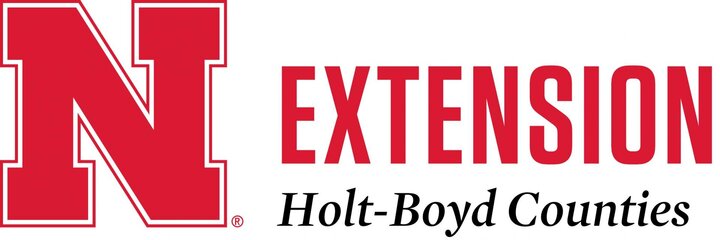
Nebraska Extension Educator - Holt/Boyd Counties - Ladonna Werth
Nebraska Extension Educator - Holt/Boyd Counties - Amy Timmerman
Nebraska Extension Educator - Brown/Rock/Keya Paha Counties - Brittany Spieker
Nebraska Extension Educator – Holt/Boyd/Garfield/Loup/Wheeler Counties – Bethany Johnston
Nebraska 4-H Assistant - Holt/Boyd Counties - Debra Walnofer
October 30: Cottage Food Producer Zoom Class, 6:00pm, Register at https://go.unl.edu/cottagefoodtraining
October 31: Nebraska and U.S. Farm Income Update and Outlook – Fall 2024, 12:00pm-1:00pm, https://unl.zoom.us/webinar/register/WN_qLFhZsJHTTqaJvbkmwJ9Ng
November 2: 4-H Shooting Sports Instructor Update Workshop, 8:30am-12:00pm, Trenton Community Building, Workshop Information & Registration - https://go.unl.edu/d8hf
November 2-3: 4-H Shooting Sports Instructor Initial Workshop, 8:00am-6:00pm, Trenton Community Building, Workshop Information & Registration - https://go.unl.edu/08qk
November 3: Boyd County 4-H Jamboree, 2:00pm, Butte Community Center, Butte, NE
November 8-10: Nebraska Youth Beef Leadership Symposium (NYBLS), Animal Science Complex, Lincoln, NE
November 11: CLOSED - Holt and Boyd County Extension Offices
November 19: Livestock Risk Management Workshop, 10:30am-2:00pm, Holt County Annex, O’Neill, NE
Alternative Party Treats
With kids, it seems there is always a reason for parties, treats or rewards. It’s easy to think of candy, cake or soda, but with more than 1 in 3 American children and adolescents overweight or obese, it is time to think about fun and healthy alternatives for party treats.
Whether it is birthday treats for school, Halloween trick-or-treats, or favors for a Christmas party at church or scouts, there are lots of great options that promote health instead of encouraging unhealthy choices.
Though overeating may be a factor in causing obesity, body weight is affected by both caloric intake and expenditure. A healthy balance is the key. So when looking for fun treats, think about more nutritious and tasty food options. Also consider non-food options that get children active in order to burn the calories they consume.
For food options, think about lower-fat foods that are high in other nutrients like fiber, vitamins and minerals. Consider items like individual packages of dried fruit or baked pretzels, fruit cups, pudding cups, or trail mix made with whole grains, dried fruit and nuts. Fresh fruit, often called nature’s candy, can also be a real treat, when appropriate to give.
There are lots of enjoyable non-food treats too, like pencils, pencil toppers or erasers, maze games, fun-shaped sticky notes, stickers or tattoos, yo-yos, marbles or whistles.
LaDonna Werth
Extension Educator
Phone: 402-336-2760
E-mail: LWerth2@unl.edu

To encourage children to be more physically active, consider small, inexpensive toys that will get them up and moving. This might be as simple as a small bouncy ball, jump rope, paddle ball, bean bag for hacky-sack, bubbles for chasing and popping, or sidewalk chalk for drawing hopscotch or a four square game. Other treats that encourage activity include reflectors, light sticks or other glow-in-the-dark items for chasing games at night, and shoelace decorations that make walking, dancing and running even more fun.
The possibilities are endless and can be used at Halloween or throughout the year for any festive occasion. Think of games, toys and ideas for party treats that delight and motivate the children in your life to move. Help them choose wisely today for a lifetime of healthy habits.
Source: Janet Hackert - Nutrition and Health Education Specialist, University of Missouri Extension (October 28, 2016)
Emergency Planning is Essential for the Home, Farm or Ranch
Everyone should have an emergency plan for their home, farm, or ranch operation. The plan doesn’t have to be complicated - it can be very simple. It also doesn’t need to cost a lot of money. Involve everyone in the family, as well as any employees. Below are some guidelines to get you started.
Identify Hazards and Risks - Consider the hazards and risks found in your area. Not everyone will have the same hazards. You may live where severe storms or wildfire risks are common. A possible hazard might even be a highway or railroad intersection near your property.
Create a Map - When seconds count, your home, farm, or ranch maps are a key source of information for first responders. Map your home property. If you have farm or ranch operations, create a map of all locations, including any land you rent. A map can help identify hazards on these properties and help you identify primary and secondary evacuation routes.
Features of the map can include:
- Buildings and structures - be sure to label these. Label and number grain bins (Grain Bin #1, Grain Bin #2).
- Roads, lanes, and driveways.
- Locations of all livestock (if you have livestock on several properties, note and map those locations).
Amy Timmerman
Extension Educator
Phone: 402-336-2760
E-mail: atimmerman2@unl.edu

- Gates, fences, and all access points.
- Irrigation pumps and wells.
- Hazardous materials (fuel, chemicals, manure pits, pipelines).
- Locations for electrical, water, and gas shutoffs.
Keep the maps simple and easy to read. Make copies and place them in binders along with other emergency information. Keep the binders in strategic locations (barn, house, vehicle) - wherever you need quick access to provide information to first responders.
Communications Plan - You may not remember important phone numbers in a disaster or even have access to your cell phone. Create a paper copy with contact information for family members, doctors, school, veterinarians, and more. Include at least one contact in another part of the state or country that everyone in the family can text to let them know they are safe. Put this list in your disaster kit and add it to your emergency plan binders.
Talk about these questions with your family:
- What if something happens and I’m not with my family or away from the farm or ranch?
- How will I reach my family or employees?
- How will we let each other know we are safe?
Make a Kit - A disaster or emergency kit or “go-bag” should provide the basic supplies for your household and/or employees while sheltering in place following a storm or if you must evacuate. Consider the needs of your family and don’t forget your pet(s). For information on building a kit, visit Ready.gov.
By being prepared and taking action now, you’ll strengthen your resilience and help protect who you love and what you love. For more resources, visit Nebraska Extension’s Disaster Education website.
Source: Sonni Cochran - Nebraska Extension Educator and Disaster Education Coordinator (CropWatch - October 10, 2024)
Getting More Out of Fall and Winter Grazing
After about 5 years of fall cover crop grazing, one thing became apparent: the amount of grazing achieved when we gave cattle access to the whole field from the start did not appear to be determined by the amount of forage that was in the field. This was because the weather seemed to determine how much trampling loss occurred. In wet years, we harvested less than 15% of the forage, and on average, we captured about 30%. Thus, it seemed worth asking the question, “Would the extra forage captured with strip grazing be worth the extra labor?” Over the past few years, we conducted a series of on-farm experiments to evaluate the effects of strip grazing on harvest efficiency and cattle performance when utilizing various annual forage resources during the late fall and winter. We had 5 cooperating producers that compared continuous grazing (giving cattle access to a whole field) vs. strip grazing with a new allocation of forage being offered once to twice a week.
What we learned:
- Strip grazing increases carrying capacity, allowing more grazing head days on the same acres. On average, strip grazing resulted in a 47% increase in grazing. This is due to less trampling losses as strip grazing lost an estimated 9% vs. 57% for continuous grazing of forage.
- When grazing growing calves, strip grazing can result in more pounds of gain per acre, and thus, a lower cost of gain. However, due to reduced forage selectivity, individual animal gain can be slightly decreased (6 to 16%).
- Higher quality forages like late-summer planted cool-season species such as oats and brassicas (rapeseed, turnips, etc.) seem to offer more return when strip grazing.
Bethany Johnston
Extension Educator
Phone: 402-336-2760
E-mail: bjohnston3@unl.edu

Bottom line, strip grazing does take a little extra effort, but the extra grazing capacity can make it worth it.
Want to hear from producers that are strip grazing?
Check out the webinar recording, “Is Strip Grazing Worth It? Getting More Out of Fall Forage Cover Crops” in which Brock and Heidi Terrell talk about their operation and give their perspectives on how cover crops fit their systems as well as the benefits of strip grazing cover crops in the fall.
Rather listen to a podcast? Check out this BeefWatch Podcast in which Doug Steffen, a producer in Eastern NE, talks about how he uses cover crops in an integrated crop and cattle operation.
Want to read more about this study?
Check out the Impact of Strip-Grazing Stockpiled Annual/Cover Crop Forages on Carrying Capacity and Animal Performance in the 2024 UNL Beef Research Report.
Source: Mary Drewnoski - Nebraska Extension Beef Systems Specialist, Erin Laborie - Nebraska Extension Educator (BeefWatch – October 25, 2024)